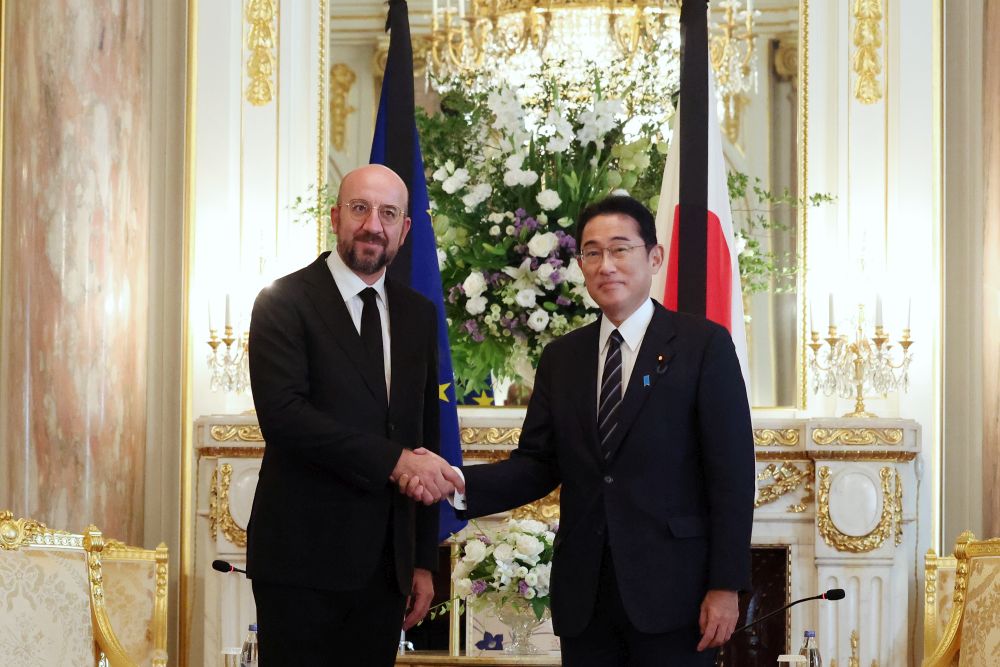Cold, hard geopolitics is back with a vengeance and the EU has decided it will not be sidelined.
The war in Ukraine is cementing this growing geopolitical role but if it is to realise its full potential, the EU must refocus on the strategically vital Indo-Pacific region.
To do this, connectivity is its most promising foreign policy tool, as it fully leverages the bloc’s phenomenal economic power. In the crowded Indo-Pacific, the EU must also reinforce multilateral coordination with its main partners, with Japan at the forefront.
A strong EU-Japan partnership can be the driving force to both uphold and modernise the liberal international order in the Indo-Pacific.
Together, Japan and the EU can promote the global digital transition based on democratic principles. Digitalisation provides the fundamental infrastructure to unlock innovation, growth and development in key global challenges beyond the digital sector, from the green transition to improved public services. It is therefore crucial that digital interoperability in the Indo-Pacific be (re)founded on freedom, openness, and a human-centric design.
An EU-Japan TTC to streamline progress
The EU-Japan strategic partnership rests on common geopolitical assessments and bilateral commitments – the 2019 Partnership on Sustainable Connectivity and Quality Infrastructure (Connectivity Partnership), the 2021 EU-Japan Green Alliance, and the Japan-EU Digital Partnership launched at the 2022 Summit.
Digitalisation is a cornerstone of EU-Japan connectivity cooperation, as highlighted by the launch of their Digital Partnership in May 2022. Both countries have committed to promoting a ‘human-centric digital transformation’ based on their digital economies and innovation capacity.
Europe and Japan’s global leadership in strong personal data protection, as well as secure cross-border data flows, could be expanded through joint investments in self-sovereign data management solutions or privacy-preserving cloud infrastructures from trusted vendors.
Operating on partner countries’ local needs and priorities and supported by the EU’s Global Gateway, these flagship initiatives offer a counterpoint to the Chinese data-extractive model in the Indo-Pacific and beyond. To speed up implementation, maximising complementarities and favouring interoperability should be a preferred strategy over jointly implementing projects.
On a governance level, the EU and Japan need to build on their cyber dialogue to deepen existing governmental cooperation mechanisms by involving industrial, technical, and educational stakeholders. This would help to expand capacity-building in cyber diplomacy and to make both nations – and their economies – more resilient to malicious actors.
To implement this approach and create a forum for shared leadership, the two partners should establish an EU-Japan Trade and Technology Council (TTC), similar to EU TTCs with the US (2021), and India (2022). Nearly all tech policy priorities of the EU-US TTC are also found in the EU-Japan Summit statement: resilient critical infrastructure and supply chains, cyber security (including secure networks), countering technology authoritarianism, surveillance and oppression, green digital and data infrastructures, and aligning safe, ethical approaches to AI.
On the Sustainable Development Goals (SDGs), by further investing in digital public infrastructures benefitting access to education, financial inclusion, public services and green technology, the TTC would allow both nations to leverage their role in championing the SDGs at home and globally. They would do so by ‘mainstreaming’ progress goals in new investments and projects in the Indo-Pacific.
This also includes the improved use of datasets and AI capabilities for Earth observation, greenhouse gases and climate data. Through joint AI R&D initiatives, existing projects being carried out by the European Space Agency and Japan’s Aerospace Exploration Agency could be matched and aligned. This would promote open-access datasets and research mobility collaborations for high-impact projects with an SDG component.
Both the EU and Japan have the necessary credentials, expertise and convening power to lead on digital connectivity. To further maximise their impact, the EU and Japan should be ambitious and actively move from bilateral to multilateral leadership.
The EU in the Indo-Pacific – many partners, few friends
The EU has been further nurturing its relationship with major Indo-Pacific actors such as India and the ASEAN states.
Japan has been doing the same. Beyond geographical and cultural closeness to Japan, these countries are central to the region’s demographic and economic growth. Their growing political importance in multilateral institutions interacts with acute development challenges – few of them have fully got back on their feet following the pandemic and many are already bearing the brunt of climate change.
As important as it is for the EU to cooperate closely with the US and Australia in the Indo-Pacific, it cannot skirt around engaging ASEAN and India beyond purely trade matters to secure influence. The obvious solution would be for Japan and the EU to join forces considering that both already share strategic partnerships with these countries.
The EU’s multifaceted partnership with ASEAN – which was upgraded to strategic in 2020 – and the bloc’s multilateral nature make it a natural partner. The first ASEAN-EU Summit on 14 December 2022 will be an opportunity for the EU to show that it can be a reliable partner in the region, beyond merely providing financial assistance.
ASEAN will also soon have to update its Master Plan on Connectivity 2025, first adopted in 2016. Coordinating with Japan to help shape a Master Plan that maximises complementarities and favours interoperability could bring tremendous EU influence over the region’s long-term connectivity landscape.
A similar triangular approach should be adopted with India by acknowledging its centrality to the Indo-Pacific and the global digital transition. India continues to foster a special relationship with Japan, its fellow Quad member, and a contributor to large amounts of strategic development assistance for India.
Beyond investment volumes, it is the way Japan operates with India that is fostering local trust. It is now clear that Indian foreign policy will follow a balancing act between Russia and the EU. The EU can reinforce its trust and resilient links with India by providing a blended connectivity offer, while fostering complementarities and favouring interoperability with Japan.
In short, the EU and Japan’s digital cooperation holds the key to maintaining and modernising the liberal international order in the Indo-Pacific. It is an opportunity that both powers should seize with enthusiasm.
Operationalising this partnership through triangulation and more horizontal policy dialogue will be decisive in countering the often opaque and nondemocratic governance in digitalisation and connectivity at large that has become more prevalent both in the region and globally.
This CEPS Expert Commentary has been written building on the discussion on: A strengthened partnership? An expert evaluation of the latest EU-Japan Summit
About the authors:


